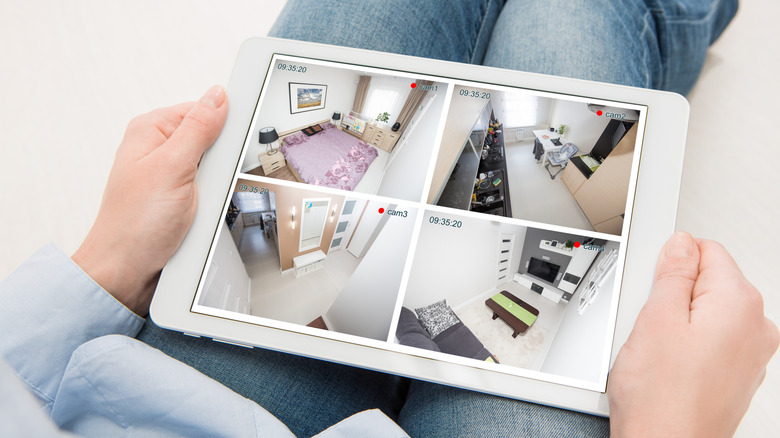How To Spot Hidden Cameras In Your Hotel Or Airbnb (Before It's Too Late)
We may receive a commission on purchases made from links.
If you're on vacation and you check into your hotel or Airbnb, you're probably thinking about the exciting adventures you're about to have. You may be ready to head right back out to enjoy a new location, or desperate to flop into the bed for a nap after a red-eye flight. What you might not be thinking about are the sneaky hidden dangers you might not have considered related to staying at one of these short-term rentals. Enter: hidden cameras. In March 2024, a family on vacation in Arizona allegedly found a hidden camera disguised as a smoke detector in the bedroom and filed a lawsuit over it. Similarly, in 2019, a couple found a camera that was directly pointed at their bed in an Airbnb they had booked in Texas, leading to the host being charged with 15 counts of invasive visual recording.
As a result, in March 2024, Airbnb banned indoor cameras in rental properties all over the world, according to an update published on their website. Similarly, Vrbo's official policy also prohibits indoor cameras, but allows smart devices that can't be operated remotely. However, guests must be informed prior and also have the option to disable them.
Still, it's a worry. That's why it's important to take a few minutes when you enter your accommodation to check for any hidden devices that could be recording your stay. While they're not foolproof, there are ways to locate hidden cameras that might give you peace of mind. The first way to check for these devices is to turn off all the lights and turn on a flashlight. Then, shine the light at all surfaces to see if there are any reflections that shouldn't be there. If there is a hidden camera somewhere, light will reflect back at you.
Looking for hidden cameras in your accommodation
In addition to the flashlight method, your phone may also be helpful with your search, since your phone's front-facing camera may be able to detect the infrared light used by some cameras. To test this, turn off the lights and have someone point a remote at you, hitting buttons. If you see flashes, it can detect infrared light. From there, look through the camera around the house for those same flashes. Alternatively, you can also use a radio frequency detector (or RF detector) — which you can purchase on Amazon — to detect bursts or blinking from cameras. Finally, you can also turn off anything that makes noise and listen closely for clicks or buzzing.
In a YouTube video from The Washington Post, security expert Joe LaSorsa also suggests looking behind things like multi-plugs and other small items in outlets to see if they have a QR code on the back. If they do, scan it. If it prompts you to connect to Wi-Fi, it may be a camera. Additionally, LaSorsa also recommends putting your phone into detect Wi-Fi mode and seeing what you find. You can also look at the guest Wi-Fi settings to see what devices are connected to it. Oh, and if you happen to unplug anything suspicious and it disappears from the network, that's another sign it might be a camera.
Finally, another great method is to put your phone into Bluetooth pairing mode to see what's there outside of smart home tech and TVs. You can also download hidden camera detection apps like Fing, which run network scans to find devices that are connected. Oh, and don't forget to read as many reviews about the property as you can to see if there are any disclosures about cameras.
Where to look for hidden cameras and what to do if you find one
In addition to knowing how to look, it can be helpful to know which places to search. While some cameras may be obvious (like the one in the picture above), others can be hidden in areas you may not notice. Ideally, you should target smoke detectors, any small holes in the wall, toys (especially if they don't seem to belong where they are), vents, shower heads, plants, alarm clocks, picture frames, nightlights and plug-in air fresheners, lamps, books and bookshelves, power strips and multi-plugs, cabinets, front door peepholes, and USB chargers.
Another thing to look at is mirrors. To test these, put your fingernail on each mirror and see if there is a gap between the nail and the reflection. If there is, it's likely a regular mirror; if there isn't, shine a light directly into it for further inspection, as it could be a two-way mirror or covering a camera. Additionally, you also don't want to use any USB ports for charging your electronics, especially after the FBI's warning about sensitive information being stolen this way. Instead, always use a charger block.
If you do find something that looks suspicious, don't disconnect it and leave it in place for any potential investigation. Document it as closely as you can with pictures and video, time and date, and include anything else that might be relevant. Then, report it to the hotel or rental company, and file a police report. Sure, it's not a comfortable thought when you first arrive somewhere for vacation, but a quick search, along with plenty of other safety tips to keep in mind when you get to your Airbnb, is definitely worth your time.


